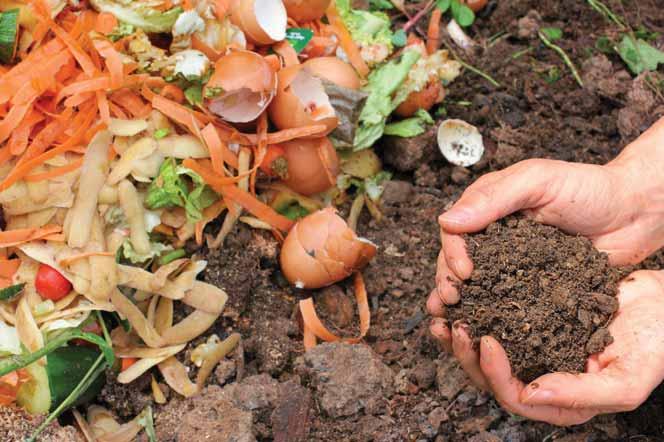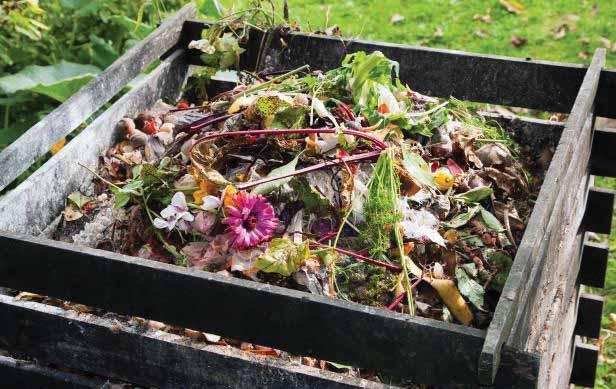
6 minute read
Creating your own ‘black gold’ at home

Preeti Mehra
Advertisement

It doesn’t matter if you live on the seventh floor of a high rise or in a ground floor house with a garden. The person with a green thumb and love for nature will always manage to conjure up green spots which sprout seasonal flowers, herbs and even vegetables. And if you are inclined to nourish your plants with healthy nutrients generated from your kitchen waste rather than harmful fertilisers, it is not difficult. To generate rich humus for the potted plants in your balcony, terrace garden, outdoor lawn, or vegetable patch, all that is needed is a little effort.
It is called composting or decomposing organic waste into simpler organic and inorganic compounds. To get started keep a separate ‘wet’ waste bin in your kitchen and instruct everyone to dispose vegetable peels, used tea leaves, ground coffee and waste food in it. The waste must then be collected and regularly emptied into a composter bin which can be kept in your balcony, terrace or a corner of the garden.
Through this simple act you will divert almost 30 per cent of your household waste away from garbage heaps and landfills. It is well-known that when organic matter is dumped in a landfill there is not enough air to decompose it quickly, hence harmful methane gas is produced as the waste breaks down. This adds to global warming which is responsible for climate change.






In contrast, when you compost, the microscopic organisms which help the process of decomposing aerate the soil. They also break down the organic material put in, nourishes the plant, and keep away plant diseases. By composting not only are you performing a green deed, but the ‘black gold’, as the humus generated is called, adds nutrients to your green shoots and helps retain soil moisture, giving you the best manure possible for your plants.
But what is the mix that goes into a healthy compost? Composting requires material rich in nitrogen (green) and carbon (brown) and the right mix of both is what gives the best results. Nitrogen-based matter includes food leftovers, leafy vegetables, and clipped grass from mowing. These provide raw material for making enzymes and help microorganisms multiply. The compost gets its body from carbon-rich material like dried leaves, eggshells, ground coffee, tea leaves, saw dust, brown paper bags or wood-derived cutlery, ice cream sticks etc. They provide the food for the microorganisms. It is best to use one-third green and two-thirds brown in the mix.
So far so good. But how does one go about composting? The easiest way is to invest in a few composting bins. These can be rotated to ensure a steady flow of manure. Buying specialised bins is convenient since it reduces the effort required in building one at home. Amazon has some 15 options, and some come with compost maker mix and jaggery to speed up the decomposing. They cost between `1,000–3,000.
It is best to read reviews of each of the options, look at the waste your kitchen generates, consider your budget, and then order the one that suits you best. The composter bins come with detailed instructions on how to set them up, what goes in at what time, and when the manure is ready to use. It usually takes between four to six weeks for the waste to be converted to compost.
There are several tips that will help you master the process of making compost. Here are a few of them: * It is advisable to chop or cut what you put in the compost bin as it speeds up decomposition. * Try to avoid adding pesticide treated material into the composter. * Collect substantial quantities of waste so that it packs the composter bin. This increases the heat inside and speeds up decomposition. * Keep the bin in the sun for a while to activate the microbes. * Stir and turn the mix occasionally to air it and speed up the composting process. Some compost bins automatically carry out this task.

With the microbes working, you are on the way to harvest your black gold. But how do you know when the manure is ready? Experts say all that needs to be done is to dig your hand into the manure. If it is warm inside, its done. Others recommended using a compost thermometer. In a compost pile that is working well the temperatures are between 140 to 160°F and can go up to a “cooking” 170°F.
Compost also needs the right amount of air and moisture (40–60 per cent) to mature. In a dry bin dampness can be enhanced by adding fresh wet waste, conversely dry waste can reduce excess moisture. But these nuances generally come through experience.
Often, residential complexes organise collective composting in larger bins or pits. That makes things easier as a system is created. But for those who want to compost at home, the proof of the pudding is in the end-product. It smells, looks, and feels like rich dark soil that deserves the epithet ‘black gold’.


Through the simple act of composting you will divert almost 30 per cent of your household waste away from garbage heaps and landfills.




The writer is a senior journalist who writes on environmental issues.


































